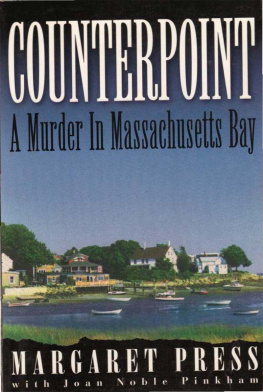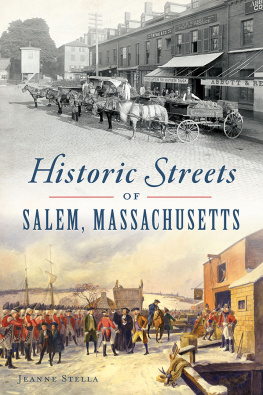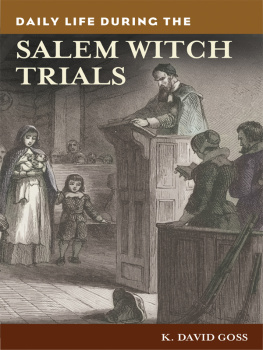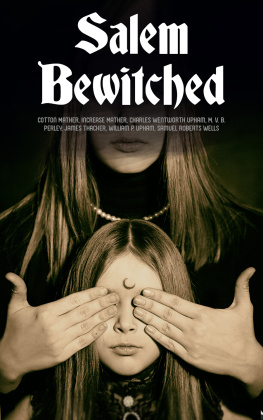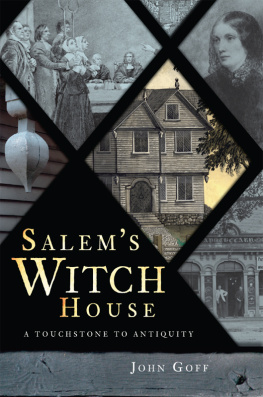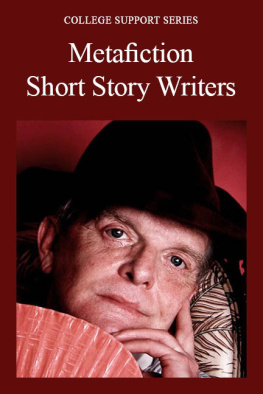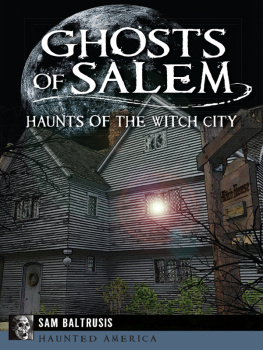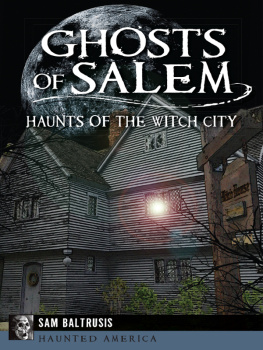
An Addicus Nonfiction Book
1996 by Margaret L Press. All rights reserved No pan of this publication may be reproduced, stored in a retrieval system, or transmitted in any form or by any means, electronic, mechanical, photocopying, recording, or otherwise, without the prior written permission of the publisher. For information write Addicus Books, Inc., P.O. Box 37327, Omaha. Nebraska 68137.
ISBN # 1-886039-24-0
The author gratefully acknowledges permission from the following to reprint material in their control:
Be My Anchor Tonight by Julie Dougherty
1991 by Julie Dougherty. All Rights Reserved. Used by Permission.
Close to Murder by Kitty Babakian
1993 by Kitty Batakian. All Rights Reserved. Used by Permission.
Under the Willows, and I But a Little Girl by Bob Franke
1987 by Telephone Pole Music Publishing Co. (BMI) All Rights Reserved. Used by Permission.
My Ballad to Martha by W.H. Goodwin III 1993 by JPT Music, All Rights Reserved. Used by Permission.
Cover photo, Salem Willows inlet, by Joan Noble Pinkham Back coverphoto, Salem Lighthouse, by Margaret Press North Shore mapby Dan Carsten
Library of Congress Cataloging-in-Publication Data
Press, Margaret I..
Counterpoint : a murder in Massachusetts Bay / Margaret Press with Joan Noble Pinkham.
p. cm.
ISBN 1-886039-24-0
1. MurderMassachusettsCase studies. 2. Brailsford, Martha, d. 1991. 3. Maimoni, Thomas J I. Pinkham, Joan Noble.
II. Title.
HV6533.M4P74 1996
96-4989
364.1523097445dc20
CIP
Printed in the United States of America
10 9 8 7 6 5 4 3 2 1
In Memory of
Martha Conant Brailsford
(1954-1991)

Acknowledgments
W ithout the help and encouragement of Detective Sergeant Conrad Prosniewski of the Salem Police Department, we never could have written this book. Much of it is his story, and we thank him for sharing it. We also express our deep appreciation for members of Marthas family who, despite their pain, shared whatever they could. Many, many other people also helped make this work possible with their insights, their memories, and their support. We are particularly grateful to those who set aside fear, grief, and privacy to talk with usincluding those who, for one reason or another, prefer not to be identified.
From the Salem Police Department we thank Chief Robert St. Pierre, Detective Sergeant Richard Urbanowicz, Lieutenant Mary Butler, Detective James Page, Detective William Jennings, Detective James Gauthier, Officer Frank Baccari, Officer Karen Pooler, Captain Paul Murphy, and Captain Paul Tucker. In addition, we thank from the Essex County District Attorneys Office Assistant District Attorney Kevin Mitchell and Victim/Witness Advocate Sandra Clark.
We also thank Paul Dejoie, Superintendent, Essex County Correctional Facility at Middleton; Robert Pino, Commonwealth of Massachusetts Crime Lab; Gerald Feigin, M.D., forensic pathologist; Attorney Jeffrey Denner; Dr. Harold Bursztajn; Rosemary Farmer; Roxcy Platte; Tucker Goodman; Dr. Raymond Mount; Charlene Colella; Hooper Goodwin III; Julie Michaud Prosniewski; David Panka; William Connolly; June Chappell; Kitty Babakian; Robert Corcoran; Attorney Edward N. Garno; Bette Greeley Rantz; Dr. Benjamin Polan; Laney Roberts, Wharf Rat Productions; Mark Wile; Dorothy Chainey; Ian Chainey; Laurie Cabot, High Priestess of Witchcraft; Dean Hartling; Peter Boyce; Mark Steele; Carmen Labrecque; Mary Norman, and Scott Clark.
We wish to extend our appreciation to Ann Green, Kaye Gordon, Richard Adamo, and Katie Hezekiah, from the Essex County Superior Courthouse.
For legal, technical, editorial, and other assistance we thank Margaret Leighton, Sara Press, Stan Anderson, Michael Johnson, Michael Gosselin, Robert Cusolito, Caleb Hanson, L. Allen Brown, Laura Driscoll, Carl Dawson, Mary Ellen Zani-Nicolopoulos, Nelson and Jane Dionne, William Press, Bobbie Bush, Jody Ray Goodwin, Joan Kendall, Priscilla Willhite, Paul Briand, The Salem Evening News, and Attorneys Howard Zaharoff, Elizabeth Ritvo, and Frank McElroy. For assistance in procuring photographs, we thank Jonathan Whitmore of The Salem Evening News. For their guidance, commitment, and abiding support, we thank our agent Susan Crawford and Rod Colvin of Addicus Books. For their endurance and encouragement, we thank our families.
We are deeply indebted to them all.
Authors Notes
I was drawn to this story from the moment in July 1991 when missing-person posters showed up on the Salem waterfront and a local police detective appeared on TV asking for viewers help. The missing womana lovely, compassionate, young artist named Martha Brailsfordhappened to be from my neighborhood. So was the man with whom she was last seena senior product engineer with Parker Brothers Games and member of a nearby yacht club.
I have a particular abiding interest in writing about Salem. The city fascinates me without end, with its mixture of crusty maritime history, its modern-day witch population, and its three-hundred year struggle with guilt. However, my genre has been mystery fiction, often based on interviews with detectives from the Salem Police. Crossing over into nonfiction meant embracing risks I wasnt sure I wanted to embrace, particularly when the people involved lived just down my street.
Nevertheless, I followed with growing passion the investigation with its surprising twists, the arraignments, pretrial hearings, and ultimately the two-week trial. By the time the verdict was handed down I knew I wanted to tell this story. It was now part of Salems history. With encouragement from the lead investigator and many others, I found the courage needed to tell it.
The entire community was fueled by shock, sadness, anger, and a need for resolution as this case progressed. But the fascinating glimpse into the complexity of human motivation is what fueled me personally. Things are not always what they seem, we learn again and again in this story. The reasons often he locked in the human mind and heart.
In the course of the research and writing, I was gifted at every turn with countless lessons in psychology, law, linguistics, philosophy, and the human condition. A window on the mind, a window on life. And provoking questions along the way: Should I now learn to be less trusting, and more fearful? Where is the line between normal and sociopathic behavior? Whats acceptable risk? Whats reasonable doubt? What would I have doneon the boat? In the jury box? The reader now faces these same tough questions.
The names and places in this book are real, with a small number of exceptions. Jennifer Eccleston and B.C. are fictitious names. The first name of Marthas husband has been changed at his request, as was the street where they lived. A couple of minor events have been told out of sequence when the actual chronology would otherwise confuse or disrupt the flow of the story. Wherever possible, dialogue has been taken from transcripts, or from the recollections of those interviewed. In some places conversations or scenes have been partially recreated, but always in conformity with known facts, and only where it was reasonable to assume they occurred.
Nearly 2500 pages of trial transcripts and hundreds more from pretrial hearings were reviewed. We also studied the case files, motions and affidavits, press clippings and numerous other sources to help shape this story. Above all, Detective Sergeant Conrad Prosniewskis unselfish granting of his time allowed focusing on the unique perspective of the investigator, his frustrations, his challenges, the skills he had to call upon, and the effects on his private life.
Next page
